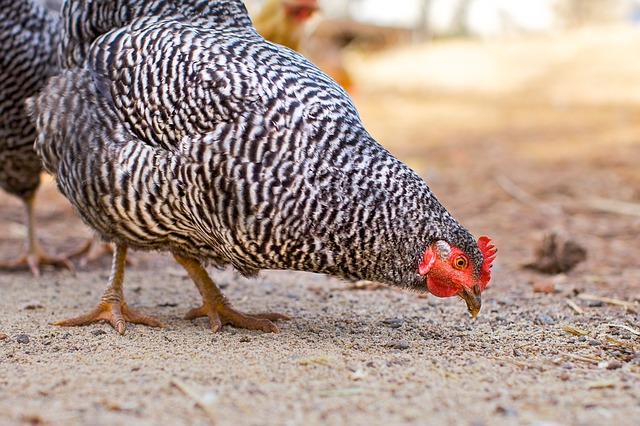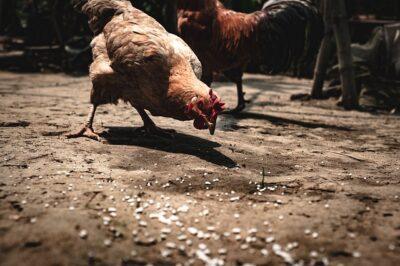The standard advice for feeding laying hens is simple: Just buy corn and layer mash. And if you’re primarily concerned with saving time and trouble, this is probably the right approach for you. But if you’re concerned with health and sustainability, you might consider another approach. Natural feeding can allow you to avoid pesticide-treated GMO corn. It also helps you make fuller use of your land’s resources in feeding your flock, and produces tastier, healthier eggs. We’ve been moving toward more natural feeding for several years, and so far we’ve been pleased with the results.
There is no one-size-fits-all approach to natural feeding. This article lays out some basic natural food sources. Don’t worry about getting the proportions exactly right. Proportions matter if you’re feeding one pre-blended ration, but if you consistently offer your hens different types of whole foods, they can select what they need. Think about what you have available, mix and match to create your feeding program, and notice how it works for your hens. Make adjustments as needed.
Outdoor Natural Feeding
Pasture
Pasture provides chickens with greens, worms and bugs; it also may include seeds and fruits. Pasture can provide a substantial portion of your flock’s energy requirements. It also provides a wide range of vitamins and minerals, and those benefits get passed on to you; eggs from pasture-raised chickens are higher in omega-3 acids and some vitamins.[i] Foraging also keeps chickens occupied and makes them less likely to attack each other.
Fully free-ranging hens get the broadest nutritional boost from their extensive pasture.
They’re also quite vulnerable to predators, they may tear up your gardens, and they may hide their eggs where you can’t find them. Electro-net or other portable fencing allows chickens to range somewhat while providing a boundary.
Unless you clip your birds’ wings, they’ll be able to fly out. Hawks also can fly in. Chicken tractors of various kinds allow you to fully enclose chickens while still providing access to fresh pasture. The tractor must be moved frequently.
Diatomaceous Earth: The All-Natural Livestock De-Wormer!
Our current chicken setup features a small A-frame yard with an open bottom which rotates around our chicken coop and chicken compost pile.
Compost
Tractored chickens are likely to exhaust the bug and worm supply in their fenced yard fairly quickly. Compost piles are a good source for bugs and worms and also give chickens a chance to enjoy scratching while not destroying their fresh pasture. We throw weeds into the compost pile throughout the year; the chickens eat parts of them, and the rest rots down and provides habitat for red wigglers, sow bugs and many other chicken treats. We water the pile when it starts to dry out. Sometimes we also lay a board down over part of the pile for a day or two at a time; flipping the board always reveals a layer of sow bugs for the chickens to gobble.
Supplements
Some people manage to raise laying hens entirely on compost and pasture. This works best if they have access to extensive piles and pastures. Many backyard growers will need to offer supplements, as we do.
Grain
Seeds are a very compact and efficient source of energy. We still buy some grain to feed our chickens. Corn and soy are the basis of most commercial chicken feeds, but we avoid these because they are usually genetically modified. Many other seeds, including wheat, oats, millet, barley and sunflower seeds, are not commercially available in GMO forms. The grains are high in energy, relatively low in protein. Sunflower seeds are high in fats and proteins. We feed a mix of wheat, oats and sunflower seed ordered from the local feed mill.
Field peas are not genetically modified now, although that may be changing in the next few years. Lentils are non-GMO and expected to stay that way for some time, according to the website GMO Compass. Both are high in protein but not fatty like sunflower seeds. Our feed mill doesn’t carry these, so we’ve had to find other protein sources.
Protein
Chickens need a high proportion of protein in their diets for health and good production. We’ve found several ways of supplementing protein with farm-raised inputs.
The pasture and compost provide some bugs and worms. Japanese beetles handpicked from our gardens are another good protein source; we collect them in a jug, pour them out into a shallow pan of water in the chicken yard, and watch the hens gobble them up. We’ve also given the hens minnows from our overstocked pond. Some poultry keepers raise red wiggler worms or soldier flies to supplement their hens’ diets.
Our chickens also get meat scraps. When we butcher rabbits, the hens get the offal. When we eat meat with bones in it the hens get the bones to pick.
Dairy products also work well for hens. They get the whey from our cheesemaking; usually we put it in a waterer and let them drink it, and sometimes we soak their grain in it. Cheeses that store too long and get too strong and sour for our taste also go to the hens.
Some poultry-keepers collect discarded food from delis or restaurants to feed their hens. This may contain a high proportion of meat and dairy products.
Vegetable Supplements
We live in upstate New York, where the ground is frozen and covered in snow for several months each year. During the winter our chickens move off the pasture and into an enclosed coop. The yolks of their eggs turn noticeably paler, as they have a more restricted diet. We periodically feed them fodder pumpkins, weeds and limp leaves from the greenhouse, leftover baked potatoes (never feed raw potatoes!), and wheatgrass to provide variety, vitamins and minerals.
What advice would you add on feeding chickens an all-natural diet? Share your tips in the section below:
[i] Jeff Mulhollem, “Research shows eggs from pastured chickens may be more nutritious,” Penn State News, July 20, 2010 (https://news.psu.edu/story/166143/2010/07/20/research-shows-eggs-pastured-chickens-may-be-more-nutritious)
Discover The Secret To Saving Thousands At The Grocery Store. Read More Here.
 Off The Grid News Better Ideas For Off The Grid Living
Off The Grid News Better Ideas For Off The Grid Living






